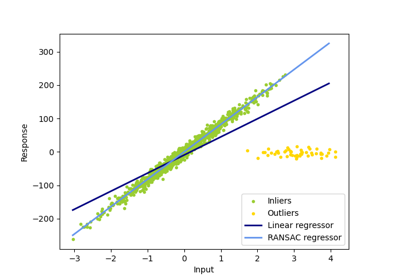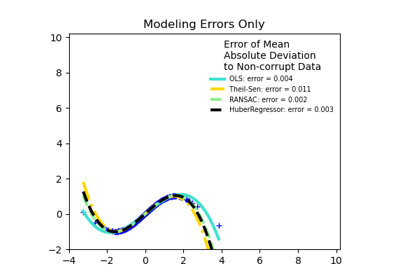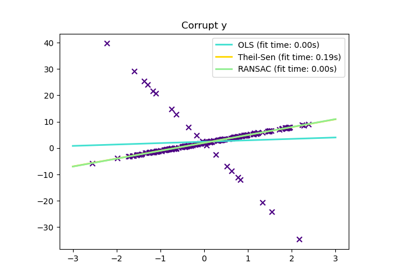-
class sklearn.linear_model.RANSACRegressor(base_estimator=None, min_samples=None, residual_threshold=None, is_data_valid=None, is_model_valid=None, max_trials=100, stop_n_inliers=inf, stop_score=inf, stop_probability=0.99, residual_metric=None, loss='absolute_loss', random_state=None)[source] -
RANSAC (RANdom SAmple Consensus) algorithm.
RANSAC is an iterative algorithm for the robust estimation of parameters from a subset of inliers from the complete data set. More information can be found in the general documentation of linear models.
A detailed description of the algorithm can be found in the documentation of the
linear_modelsub-package.Read more in the User Guide.
Parameters: base_estimator : object, optional
Base estimator object which implements the following methods:
-
fit(X, y): Fit model to given training data and target values. -
score(X, y): Returns the mean accuracy on the given test data, which is used for the stop criterion defined bystop_score. Additionally, the score is used to decide which of two equally large consensus sets is chosen as the better one.
If
base_estimatoris None, thenbase_estimator=sklearn.linear_model.LinearRegression()is used for target values of dtype float.Note that the current implementation only supports regression estimators.
min_samples : int (>= 1) or float ([0, 1]), optional
Minimum number of samples chosen randomly from original data. Treated as an absolute number of samples for
min_samples >= 1, treated as a relative numberceil(min_samples * X.shape[0]) formin_samples < 1. This is typically chosen as the minimal number of samples necessary to estimate the givenbase_estimator. By default asklearn.linear_model.LinearRegression()estimator is assumed andmin_samplesis chosen asX.shape[1] + 1.residual_threshold : float, optional
Maximum residual for a data sample to be classified as an inlier. By default the threshold is chosen as the MAD (median absolute deviation) of the target values
y.is_data_valid : callable, optional
This function is called with the randomly selected data before the model is fitted to it:
is_data_valid(X, y). If its return value is False the current randomly chosen sub-sample is skipped.is_model_valid : callable, optional
This function is called with the estimated model and the randomly selected data:
is_model_valid(model, X, y). If its return value is False the current randomly chosen sub-sample is skipped. Rejecting samples with this function is computationally costlier than withis_data_valid.is_model_validshould therefore only be used if the estimated model is needed for making the rejection decision.max_trials : int, optional
Maximum number of iterations for random sample selection.
stop_n_inliers : int, optional
Stop iteration if at least this number of inliers are found.
stop_score : float, optional
Stop iteration if score is greater equal than this threshold.
stop_probability : float in range [0, 1], optional
RANSAC iteration stops if at least one outlier-free set of the training data is sampled in RANSAC. This requires to generate at least N samples (iterations):
N >= log(1 - probability) / log(1 - e**m)
where the probability (confidence) is typically set to high value such as 0.99 (the default) and e is the current fraction of inliers w.r.t. the total number of samples.
residual_metric : callable, optional
Metric to reduce the dimensionality of the residuals to 1 for multi-dimensional target values
y.shape[1] > 1. By default the sum of absolute differences is used:lambda dy: np.sum(np.abs(dy), axis=1)
NOTE: residual_metric is deprecated from 0.18 and will be removed in 0.20 Use
lossinstead.loss : string, callable, optional, default ?absolute_loss?
String inputs, ?absolute_loss? and ?squared_loss? are supported which find the absolute loss and squared loss per sample respectively.
If
lossis a callable, then it should be a function that takes two arrays as inputs, the true and predicted value and returns a 1-D array with the ``i``th value of the array corresponding to the loss onX[i].If the loss on a sample is greater than the
residual_threshold, then this sample is classified as an outlier.random_state : integer or numpy.RandomState, optional
The generator used to initialize the centers. If an integer is given, it fixes the seed. Defaults to the global numpy random number generator.
Attributes: estimator_ : object
Best fitted model (copy of the
base_estimatorobject).n_trials_ : int
Number of random selection trials until one of the stop criteria is met. It is always
<= max_trials.inlier_mask_ : bool array of shape [n_samples]
Boolean mask of inliers classified as
True.References
[R179] https://en.wikipedia.org/wiki/RANSAC [R180] http://www.cs.columbia.edu/~belhumeur/courses/compPhoto/ransac.pdf [R181] http://www.bmva.org/bmvc/2009/Papers/Paper355/Paper355.pdf Methods
fit(X, y[, sample_weight])Fit estimator using RANSAC algorithm. get_params([deep])Get parameters for this estimator. predict(X)Predict using the estimated model. score(X, y)Returns the score of the prediction. set_params(\*\*params)Set the parameters of this estimator. -
__init__(base_estimator=None, min_samples=None, residual_threshold=None, is_data_valid=None, is_model_valid=None, max_trials=100, stop_n_inliers=inf, stop_score=inf, stop_probability=0.99, residual_metric=None, loss='absolute_loss', random_state=None)[source]
-
fit(X, y, sample_weight=None)[source] -
Fit estimator using RANSAC algorithm.
Parameters: X : array-like or sparse matrix, shape [n_samples, n_features]
Training data.
y : array-like, shape = [n_samples] or [n_samples, n_targets]
Target values.
sample_weight : array-like, shape = [n_samples]
Individual weights for each sample raises error if sample_weight is passed and base_estimator fit method does not support it.
Raises: ValueError :
If no valid consensus set could be found. This occurs if
is_data_validandis_model_validreturn False for allmax_trialsrandomly chosen sub-samples.
-
get_params(deep=True)[source] -
Get parameters for this estimator.
Parameters: deep : boolean, optional
If True, will return the parameters for this estimator and contained subobjects that are estimators.
Returns: params : mapping of string to any
Parameter names mapped to their values.
-
predict(X)[source] -
Predict using the estimated model.
This is a wrapper for
estimator_.predict(X).Parameters: X : numpy array of shape [n_samples, n_features]
Returns: y : array, shape = [n_samples] or [n_samples, n_targets]
Returns predicted values.
-
score(X, y)[source] -
Returns the score of the prediction.
This is a wrapper for
estimator_.score(X, y).Parameters: X : numpy array or sparse matrix of shape [n_samples, n_features]
Training data.
y : array, shape = [n_samples] or [n_samples, n_targets]
Target values.
Returns: z : float
Score of the prediction.
-
set_params(**params)[source] -
Set the parameters of this estimator.
The method works on simple estimators as well as on nested objects (such as pipelines). The latter have parameters of the form
<component>__<parameter>so that it?s possible to update each component of a nested object.Returns: self :
-
linear_model.RANSACRegressor()
Examples using
2025-01-10 15:47:30



Please login to continue.